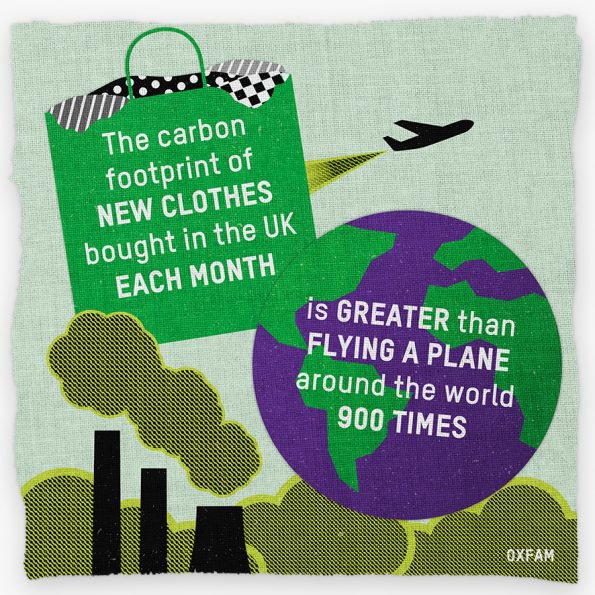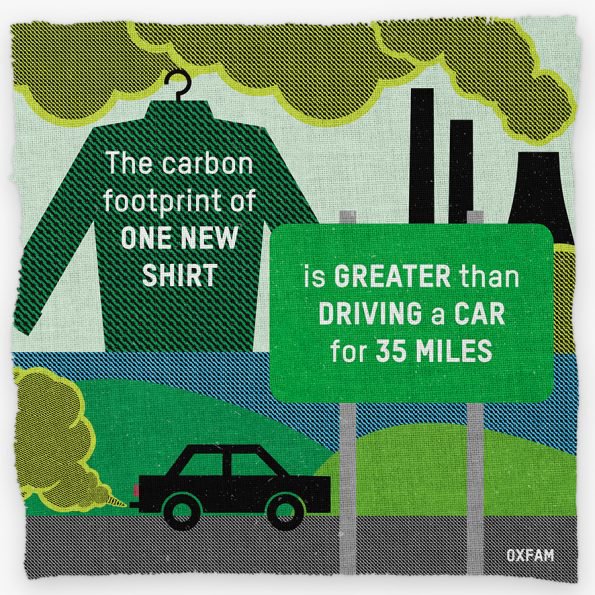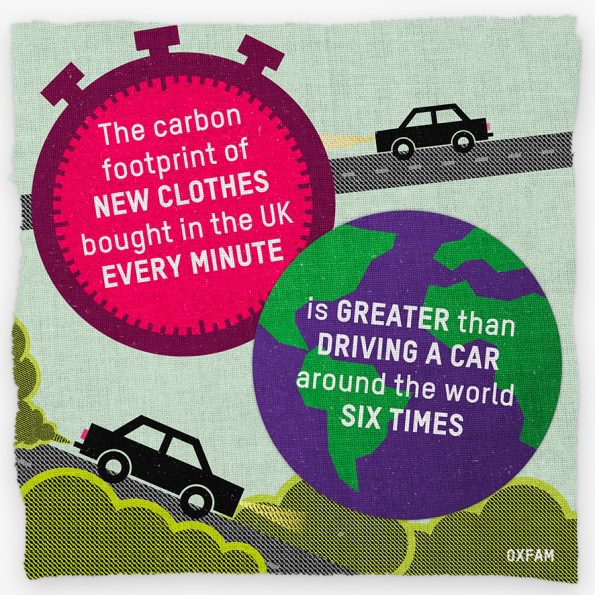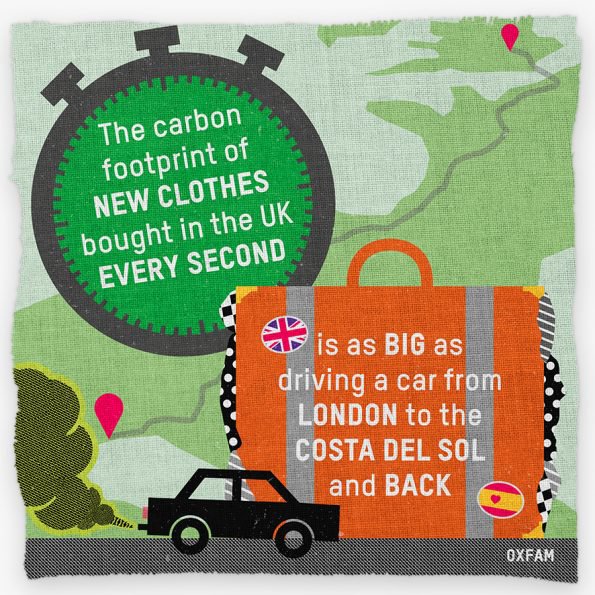New Shocking Facts about the Impact of Fast Fashion on our Climate
Our planet is in serious trouble and our nation’s addiction to new clothes is doing more harm than you may think.
11 fast fashion facts and statistics
- The world uses an estimated 80 billion pieces of clothing every year, a 400 percent increase from two decades ago. — The True Cost
- Textile production contributes more to climate change than international aviation and shipping combined. — House of Commons Environmental Audit Committee, 2019
- Buying just one white cotton shirt produces the same amount of emissions as driving 35 miles in a car. —WRAP
- By 2030, global apparel consumption is projected to rise by 63%, from 62 million tons today to 102 million tons—equivalent to more than 500 billion additional T-shirts. — House of Commons Environmental Audit Committee, 2019
- 75% of consumers believe that sustainability is important and one-third are willing to choose brands that help environmental and social improvement. — Ellen MacArthur Foundation
- The fashion industry is responsible for 10% of annual global carbon emissions. — Morgan McFall-Johnsen (2020)
- Half a million tons of plastic microfibers are dumped into the ocean every year, the equivalent of 50 billion plastic bottles. — World Economic Forum
- Around 300,000 tonnes of textile waste ends up in household black bins every year, sent to landfill or incinerators. Less than 1% of material used to produce clothing is recycled into new clothing at the end of its life. — House of Commons Environmental Audit Committee, 2019
- Clothing companies create more than 1 million garments every day. — Greenpeace
- Fast fashion emissions will grow by 50% by 2030, if current growth continues. — Ellen MacArthur Foundation
- Extending the life of clothes by just 9 months of active use would reduce carbon, water and waste footprints by 20-30% each. — WRAP
It’s estimated that more than two tonnes of clothing are bought each minute in the UK, more than any other country in Europe. That amount produces nearly 50 tonnes of carbon emissions, the same as driving 162,000 miles in a car.
In one month alone, the carbon footprint of new clothes bought in the UK was greater than flying a plane around the world 900 times. This is the same amount of carbon emissions the nation could save if we all took part in Second Hand September.
Why do we need a sustainable approach to fashion?
- Fast fashion clothes are produced in high volume which means a high cost to the planet: 10% of global CO2 emissions are caused by the textile industry – that’s more than international aviation and shipping combined
- The fashion industry produces 20% of global wastewater. The Global Fashion Agenda (GFA) and the Boston Consulting Group (BCG) anticipate that water use will increase by 50% by 2030 — Fashion United
- In the UK, we buy more clothes per person than any other country in Europe.
- Around 300,000 tonnes of clothing end up in household bins every year, with around 20% going to landfill and 80% incinerated. One report shows evidence that when synthetic textiles are landfilled or incinerated, they can leach harmful microfibres into the environment
- Clothes are produced cheaply which often means low wages and poor working conditions for garment workers. With rising labour costs in countries like China and Bangladesh, garment brands are looking to new markets where labour costs are low, often because there is no legal minimum wage because governments are keen not to discourage foreign investment by increasing these costs
- According to the EAC report, 20-35% of all primary source microplastics in the marine environment are from synthetic clothing. A single 6kg domestic wash has the potential to release as many as 700,000 fibres
- The same report explains that while incineration of unsold stock ‘recovers’ some energy from the products, it multiplies the climate impact of the product by generating further emissions and air pollutants
- The average consumer now buys 60% more clothing than they did 15 years ago — The UN Alliance for Sustainable Fashion
World Economic Forum / Valeriano Di Domenico
We are facing a disaster of unspoken sufferings for enormous amounts of people.”
Greta Thunberg
In 2019, then 16-year-old climate activist Greta Thunberg stood up in front of world leaders at Davos to deliver a chilling wake up call:
Greta sparked a wake-up call across the globe demanding drastic change to save our planet and in turn, ourselves. We’re all feeling the effects of the climate emergency, but it is not affecting us all equally.
The world's poorest people have contributed the least to the climate crisis, yet are suffering the full force of its impacts: increased flooding, droughts and storms destroying lives, homes, jobs, livestock and crops.
When Greta said, “our house is on fire” she wasn’t wrong. We are seeing unprecedented wild fires spreading across the Amazon rainforest, the lungs of our planet, producing 20% of the world’s oxygen. Greenland’s ice sheet is melting so fast it has caused global sea levels to rise 0.5mm in just one month.
Farmers like Hudan in Ethiopia are having to adapt in a drastically warming world to months without rainfall. Our planet is in serious trouble.
But things could be different. As Greta pointed out “The main solution is so simple that even a small child can understand. We have to stop our emissions of greenhouse gases.”
Obvious actions stand out – flying less, driving less, taking more public transport. But how about buying fewer new clothes? With the global textile industry producing more greenhouse gas emissions than international aviation and shipping combined – it could be a more important change than we think.
Reducing the impact of fast fashion
Reducing the impact of fast fashion is a growing trend, with many people buying vintage and second hand clothing. This is backed up in Co-op's report Twenty Years of Ethical Consumerism. Before the coronavirus pandemic, charity shop sales had increased four-fold from £133m to £732m in 20 years.
- Extending the average life of clothes by just nine months would save £5 billion in resources used to supply, launder and dispose of clothing. — WRAP research
- If the number of times a garment is worn were doubled on average, Greenhouse gas emissions would be 44% lower — Ellen MacArthur Foundation, A new textiles economy: Redesigning fashion’s future
Oxfam shops pioneered the idea of fair trade back in the 1960s. Paying people a fair and decent price for the goods they produce, and giving workers a say in the future of their company. On top of that, today we have many UK-made planet-conscious products we’ve added to the ethically sustainable range.
Oxfam has over 550 shops in the UK. By buying and donating your clothes through Oxfam shops, you can help to protect our planet, while helping the people around the world to escape the injustice of poverty. Find your local Oxfam shop or visit Oxfam's Online Shop.
How does fast fashion affect the environment?
The impact of plastic fibres on the environment cannot be ignored. These tiny particles are polluting the oceans, entering our waterways and contaminating our food chain. However, plastic fibres are not the only environmental issue caused by the fashion industry. Wastewater contaminated with toxic dyes and the use of harmful chemicals also contribute to the industry's devastating impact on the planet.
Fast fashion pollution
Fast fashion relies on cheap, disposable clothing that is produced quickly and sold at low prices, encouraging consumers to buy and discard clothing at an alarming rate. As a result, landfills are overflowing with discarded clothing, and textile waste is piling up.
The pollution caused by fast fashion is an issue that requires urgent attention, and consumers can play an important role in driving change by supporting sustainable and ethical fashion brands, choosing high-quality clothing that lasts longer, and recycling or repurposing clothing when it is no longer needed.
A path towards a greener future
Fast fashion is big business, but experts are suggesting that there is a better way forward: a circular economy for textiles. By implementing a circular approach, we can reduce the amount of waste generated, decrease our reliance on virgin materials, and ultimately mitigate the fashion industry's environmental footprint. With greater investment in sustainable practices, the fashion industry can play a positive role in creating a more sustainable future.
What is the impact of fast fashion on garment workers worldwide?
- A Bangladeshi worker would need to be paid 4.5 times more than the current minimum wage to afford a decent living standard and almost 9x more to support a family. — WageIndicator Foundation
- Garments are the second highest at-risk product for modern slavery — Fashion Revolution
How does Oxfam support garment workers facing poverty around the world?
- Since 2017, Oxfam Australia’s What She Makes campaign has been asking big clothing brands to pay garment workers a living wage
- We work directly with the garment sector and low-paid workers. Like in Bangladesh, where we support people to access markets, know their rights and challenge social attitudes
How is racism and gender discrimination linked to fast fashion?
Racism and gender discrimination are at the centre of fast fashion. Many garment workers are people of colour, and roughly 80% are women, employed under poor working conditions. The colonial roots of the fashion industry are still evident today, with the extraction of resources and exploitation of labour from people.
Help raise awareness of how damaging our shopping habits can be
Share these graphics on your social channels.




